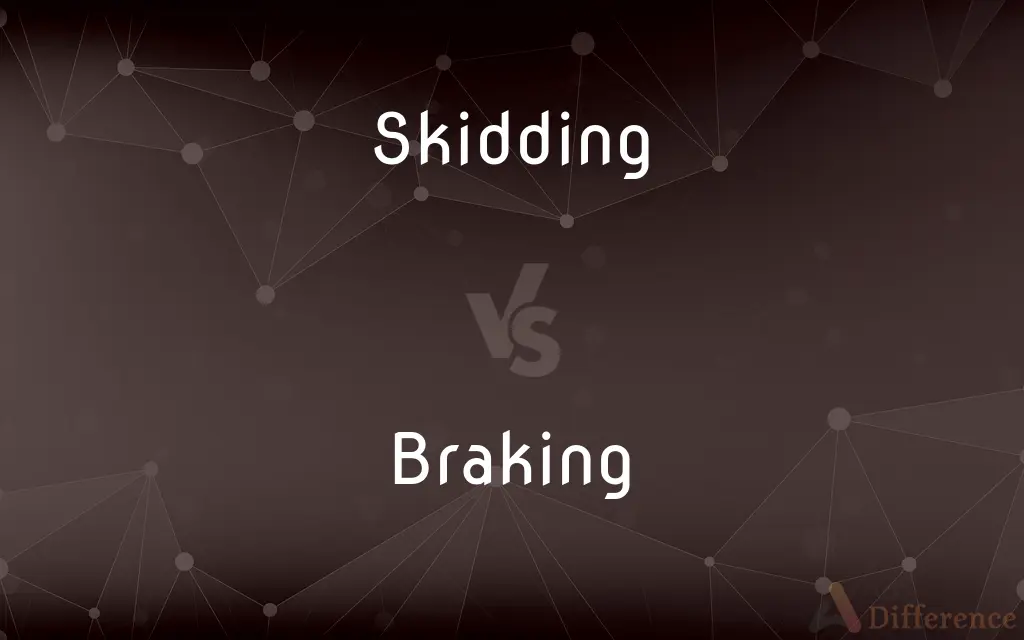Skidding vs. Braking — What's the Difference?
By Fiza Rafique & Maham Liaqat — Updated on March 17, 2024
Skidding is losing traction during movement; braking involves reducing speed or stopping through friction.

Difference Between Skidding and Braking
Table of Contents
ADVERTISEMENT
Key Differences
Skidding occurs when a vehicle's tires lose traction with the road surface, resulting in uncontrolled sliding. This can happen due to various reasons, such as sudden turns, braking too hard, or slippery conditions caused by ice, snow, or wet surfaces. Skidding is generally considered dangerous because it significantly reduces the driver's ability to control the vehicle, potentially leading to accidents. On the other hand, braking refers to the process of slowing down or stopping a vehicle by applying resistance through the braking system, which usually involves components like brake pads or shoes pressing against a disc or drum to create friction.
While braking is an intentional action taken to reduce speed or come to a halt, skidding is often an unintended consequence of braking too hard or other factors that cause a loss of grip. Braking effectively requires an understanding of the vehicle's braking system and the road conditions, as improper braking can lead to skidding. Modern vehicles often come equipped with anti-lock braking systems (ABS) to prevent skidding by allowing the wheels to maintain traction with the road surface while braking.
The distinction between skidding and braking is crucial for safe driving. Effective braking techniques, such as gradual pressure on the brake pedal and understanding how to use ABS, can help prevent skidding. Conversely, if a vehicle begins to skid, the driver must know how to react properly, such as steering in the direction of the skid to regain control, which contrasts with the preventive measure of controlled braking.
Skidding can be more common in certain driving conditions, emphasizing the importance of adjusting driving habits and braking techniques to match the environment. For example, braking gently and early is recommended on slippery surfaces to avoid skidding. In comparison, braking can be performed more confidently on dry roads with good traction, where the risk of skidding is lower.
Comparison Chart
Definition
The act of sliding uncontrollably on a surface.
The action of applying resistance to slow down or stop.
ADVERTISEMENT
Cause
Loss of traction due to various factors like icy roads.
Intentional application of the vehicle's brake system.
Control
Reduced ability to steer or control the vehicle.
Controlled deceleration or stopping of the vehicle.
Technique
Requires corrective action (e.g., steering into the skid).
Involves proper use of brake system, potentially with ABS.
Safety
Can lead to accidents if not properly managed.
Aims to safely reduce speed or stop, preventing accidents.
Compare with Definitions
Skidding
Can occur during sudden turns or braking.
He lost control and skidded when he braked sharply at the corner.
Braking
Essential for vehicle control and safety.
Effective braking is crucial for avoiding accidents.
Skidding
More likely in adverse weather conditions.
Skidding is common during winter due to snow and ice.
Braking
Involves the vehicle's brake system.
The driver applied the brakes to slow down for the curve.
Skidding
Requires corrective steering to regain control.
To stop the skid, she steered gently in the direction of the slide.
Braking
To be slowed or stopped by or as if by the operation of a brake.
Skidding
A loss of traction resulting in sliding.
The car started skidding on the icy road.
Braking
Can be gradual or sudden, depending on the need.
Gradual braking helps prevent wear on the brake pads.
Skidding
Skids Nautical A wooden framework attached to the side of a ship to prevent damage, as when unloading.
Braking
The process of slowing or stopping movement through friction.
She started braking as soon as she saw the stop sign.
Skidding
Indicates a temporary loss of vehicle control.
The skidding vehicle narrowly missed hitting the barrier.
Braking
Techniques vary with driving conditions.
On wet roads, gentle braking is advised to avoid skidding.
Skidding
The action of sliding or slipping over a surface, often sideways.
Braking
A device for slowing or stopping motion, as of a vehicle, especially by contact friction.
Skidding
A shoe or drag applying pressure to a wheel to brake a vehicle.
Braking
Something that slows or stops action.
Skidding
A period of sharp decline or repeated losses
Bad economic news sent the markets into a skid. The win ended the team's four-game skid.
Braking
A toothed device for crushing and beating flax or hemp.
Skidding
A plank, log, or timber, usually one of a pair, used as a support or as a track for sliding or rolling heavy objects.
Braking
A heavy harrow for breaking clods of earth.
Skidding
A pallet for loading or handling goods, especially one having solid sideboards and no bottom.
Braking
An apparatus for kneading large amounts of dough.
Skidding
One of several logs or timbers forming a skid road.
Braking
A machine for bending and folding sheet metal.
Skidding
A runner in the landing gear of certain aircraft.
Braking
A high horse-drawn carriage with four wheels.
Skidding
Skids A path to ruin or failure
His career hit the skids. Her life is now on the skids.
Braking
To reduce the speed of with or as if with a brake.
Skidding
To slide, especially roughly or heavily
The crate broke loose and skidded across the slanting deck.
Braking
To operate or apply a brake.
Skidding
To slide sideways while moving because of loss of traction
The truck skidded on a patch of ice.
Braking
To crush (flax or hemp) in a toothed device.
Skidding
To slide from forward momentum, especially during an attempt to stop
Braked hard and skidded to a stop.
Braking
To break up (clods of earth) with a harrow.
Skidding
To move sideways in a turn because of insufficient banking. Used of an airplane.
Braking
A past tense of break.
Skidding
(Informal)To fall or decline sharply
"That news immediately sent bonds skidding to new lows" (Wall Street Journal).
Braking
Present participle of brake
Skidding
To brake (a wheel) with a skid.
Braking
The act of applying brakes.
The acceleratings and brakings of a vehicle
Skidding
To haul on a skid or skids.
Skidding
Present participle of skid
Skidding
The motion of something that skids.
Common Curiosities
How does ABS help prevent skidding?
ABS prevents skidding by automatically modulating brake pressure to keep tires from locking up, maintaining traction while braking.
Is skidding always dangerous?
Skidding can be dangerous as it reduces control over the vehicle, but knowing how to react can mitigate risks.
What causes a vehicle to skid?
A vehicle skids when its tires lose traction with the road, often due to slick conditions or abrupt maneuvers.
How can I prevent skidding while driving?
Prevent skidding by maintaining appropriate speeds, avoiding sudden turns or stops, and using tires suitable for driving conditions.
What should I do if my car starts to skid?
If your car starts to skid, steer gently in the direction you want to go and avoid abruptly braking or accelerating.
Can braking too hard cause skidding?
Yes, braking too hard can cause the tires to lock up and skid, especially on slippery surfaces or if the vehicle lacks ABS.
What's the difference between skidding and hydroplaning?
Hydroplaning is a specific type of skidding that occurs when tires ride on a layer of water, losing contact with the road.
How do weather conditions affect skidding and braking?
Adverse weather, like rain or snow, can reduce traction, increasing the risk of skidding and affecting braking efficiency.
What is the purpose of braking?
The purpose of braking is to slow down or stop a vehicle safely.
What role do tires play in skidding and braking?
Tires play a crucial role; good tire condition and appropriate tire types for the weather can improve traction and reduce skidding risks.
Why might a vehicle still skid despite having ABS?
ABS helps prevent skidding during braking, but it can't overcome all conditions, such as extremely slippery surfaces or inappropriate speed.
What is the safest way to brake on a slippery surface?
The safest way is to brake gently and gradually to avoid locking the tires and losing traction, especially if the vehicle doesn't have ABS.
Can skidding be intentional in any scenario?
In some driving sports, like drifting, skidding is intentional and controlled, but it requires skill and is not advisable on public roads.
How do I use brakes effectively in an emergency?
In an emergency, apply steady pressure to the brake pedal; if your vehicle has ABS, it will help prevent skidding.
Can all vehicles use the same braking techniques?
Different vehicles may require different braking techniques, influenced by their weight, design, and brake system capabilities.
Share Your Discovery

Previous Comparison
Absolutely vs. Completely
Next Comparison
Setup vs. SettingAuthor Spotlight
Written by
Fiza RafiqueFiza Rafique is a skilled content writer at AskDifference.com, where she meticulously refines and enhances written pieces. Drawing from her vast editorial expertise, Fiza ensures clarity, accuracy, and precision in every article. Passionate about language, she continually seeks to elevate the quality of content for readers worldwide.
Co-written by
Maham Liaqat















































